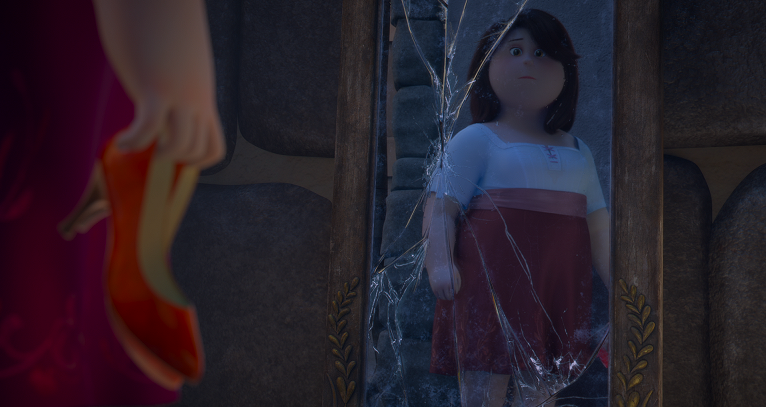Animated: Princesses make modern dreams come true

Like many people, I grew up with Disney films. It sounds cliché, but I really did want to be a princess and live out my fantasy. My idea of a fun weekend was visiting the Walt Disney Family Museum in San Francisco’s Presidio, where I’d search for all the background stories of my favorite Disney princesses. From dressing up as Belle to rewatching “The Little Mermaid” whenever I was feeling down, I loved — and still love — Disney princess movies and the happily ever afters they represent.
Because I’ve always been drawn to fairytales and princesses, it makes sense to think reimaginings of fairytales in animation have so much potential. As overused as it may be, I don’t think the “princess” trope is necessarily outdated, nor should it be banished. In fact, it’s because princesses occupy such an important space in contemporary pop culture that I think they need to be recentered and made more inclusive.
Just look at Harvard student Julia Riew, who made headlines earlier this year for writing her own full-length musical inspired by a Korean folk tale. “Shimcheong: A Folktale” features a Korean princess and made its viral debut in Riew’s TikTok video, in which an animated version of Riew sings her original song, “Dive.” The text introducing the video states, “There was no Korean Disney princess so I decided to make my own.”
Beyond writing narratives inspired by folklore, creators also take beloved European fairytales and craft them for a modern audience. The animated film “Red Shoes and the Seven Dwarfs” (2019) attempts to reimagine the story of Snow White. As a whole, the narrative lacks compared to the popular Disney princess films — here, relationships between characters appear to be built more on classic fairytale tropes than actual, carefully crafted development.
However, the film has to be commended for its visually gorgeous animation and ability to represent fairytale elements in a new light. The story takes a spin on the classic Snow White narrative. In this iteration, Snow White is plus-size and transforms into a “thin” version of herself by wearing magical red shoes.
Snow White’s father, the king, has gone missing. Snow White must evade her evil stepmother and enlist the help of seven dwarfs — who are actually princes under a curse — to help her find her father.
As someone who doesn’t conform to the visual archetype of the Disney princesses that I grew up loving so much, I found “Red Shoes and the Seven Dwarfs” an inspiring new take on what makes someone truly a “princess.” Even as I grew up watching Disney princess movies, I couldn’t shake the feeling that being a princess relied more on one’s appearance than one’s personality. To truly be a princess, princes had to fall in love with you just by looking at you and people would sing songs praising your beauty, which would conform to their standards of thinness (see: “Belle”) — this was an ideal that I was indoctrinated into.
Because of that, I liked that “Red Shoes and the Seven Dwarfs” had a princess who was more like me. Here was a girl who loved eating desserts and was OK with not being traditionally thin. She didn’t have the traditional fairytale body shape of princesses, one that I had thought was the measure of “attractiveness.” I felt represented, as if I could be a princess too.
Snow White’s internal conflict about being “beautiful” struck me to my core, especially given the fact that the dwarfs, or princes, needed a beautiful woman’s kiss to break their curse. Would the princes still help her find her father if she didn’t conform to their vision of beauty? Would she be accepted for who she was if she wasn’t their version of a beautiful princess?
From a storytelling point of view, Snow White’s alter ego, the thin “Red Shoes,” felt symbolically powerful. In a way, the character of “Red Shoes” revealed the complicated underpinnings of fantasy. “Red Shoes” was the princes’ fantasy. She wasn’t Snow White.
Despite the film’s message of self-love, its marketing fed into the very same pressures that it wanted to critique. “Red Shoes and the Seven Dwarfs” was embroiled in controversy because of its insensitive billboard at the 2017 Cannes Film Festival, which centered the line: “What if Snow White was no longer beautiful and the 7 Dwarfs not so short?” The billboard juxtaposed the plus-size Snow White and her thin form, implying that being plus-size meant that one wasn’t beautiful.
The campaign’s fat-shaming was widely rebuked and serves as a testament to the difficulty of distancing fairytale reimaginings from the fairytale ideals that inspired them. For a film that rebels against shallowness, it was disheartening to see its marketing promote the opposite.
In considering these animated fairytales, this seems to be the paradox of princesses. How can we dismantle fairytales’ lack of inclusiveness while also playing into their significance? Can we truly rewrite magic and shape our own happily ever afters?
It’s a challenge, but that doesn’t mean we shouldn’t try. To represent ourselves as we are — that’s the realest kind of fantasy there is.
Valerie Wu is a junior writing about animation and digital arts from a contemporary perspective. Her column “Animated” runs every other Friday.

